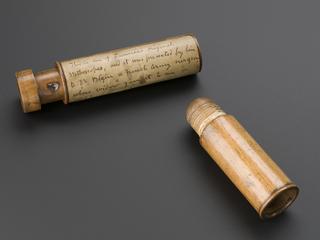
Piorry type monaural stethoscope
- Made:
- 1834-1883 in unknown place




Piorry type monaural stethoscope.
French physician René Théophile Laennec (1781-1826) invented the stethoscope in 1816. Stethoscopes listen to the sounds of the body’s operation. These sounds are indicators of the body’s functioning. The heart is usually listened to. However, the lungs and intestines also reveal characteristic sounds.
The original design was made of wood and brass. It consisted of a single hollow tube. This early adaptation is by Pierre Adolphe Piorry (1794-1879) from 1829. It is trumpet-shaped and made of wood. It was thinner and lighter than its forerunner. It kept to a single ivory earpiece used by Laennec and a chest piece.
Stethoscopes with two earpieces (binaural) were introduced in the 1850s. The stethoscope hanging around the neck has been a symbol of the scientific doctor.
Details
- Category:
- Clinical Diagnosis
- Collection:
- Sir Henry Wellcome's Museum Collection
- Object Number:
- A600062
- Materials:
- wood (unidentified), ivory and complete
- Measurements:
-
overall: 180 mm 52 mm, .045 kg
- type:
- stethoscope
- credit:
- Wolfendale, G.A.




